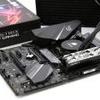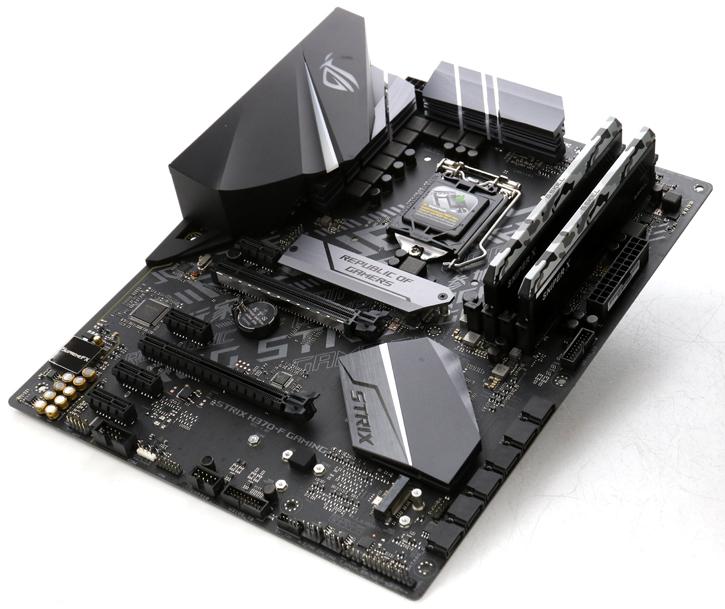Final Words & Conclusion
Conclusion
Well, if this is what the new mainstream/ budget/value motherboards will look like, bring them on. Intel has waited a long time before releasing a more affordable chipset for the 8th generation (Coffee Lake) processors. The H370 series is going to be as fast as a Z370 chipset, there's no doubt about that. Since it is as fast, Intel needed to cut away and limit some stuff, being tweaking options, a fixed DDR4 memory frequency at 2667 MHz and smaller chipset limitations in the form of four less PCIe Gen 3.0 lanes. In the end though, if you are savvy with one graphics card and one full speed M.2 SSD, you are still at the same perf level as a non-tweaked Z370 platform, that fixed 2667 MHz memory speed really isn't that dramatic for anything with an Intel chip. Pair it with, say, a Core i5 8600 (non-K model), and you'll have an incredibly fast gaming rig. So if all this sounds good to you, the reality will be that
Performance & tweaking
We have had a good look at the H370 motherboard, all with the latest BIOS, this H370 once again felt solid overall. Paired with the right processor you can achieve terrific performance, again, recommended again would be a Core i5 8600 (review), which I find to be a tremendous sweet spot. It is a non-K model, which applies to this non-tweakable board. Even with the cut-off on DDR4 memory frequency, you need to realize Intel has been able to refine their memory controllers, pop in anything XMP 2.0. So yes, CPU performance based on this chipset, the baseline we cannot complain about. SATA3, USB 3.x, and NVMe also reveal proper performance.
Power consumption
We actually tested both an 8600 non-K and 8700K on this motherboard but used the 8700K as the baseline test, and yeah, a six-core, twelve threaded proc equals a 95 Watt TDP processor. With the system at idle with a GeForce GTX 1080 installed / 16 GB memory / SSD and the H370 motherboard, I hovered at roughly 35 Watts in IDLE which is just impressive, the load values are okay as well, fairly similar for both procs. When we stressed the processor 100% we reach roughly 140 Watts with the 6-core 8700K part. When we game we hover at ~250 Watts with the GeForce GTX 1080, but obviously that factor is dependent on the type of graphics card you use of course and, sure, most games certainly do not utilize the six CPU cores. Overall I have no worries here.
DDR4 Memory
For Coffee Lake (8th Gen Intel procs) DDR4 may be clocked a notch faster at 2400 MHz as per Intel reference, there is, of course, a hard lock at 2667 MHz. We always say, volume matters more than frequency. A 3,200 MHz kit, for example, is more expensive, does offer better bandwidth but the performance increases in real-world usage will be hard to find compared to a cheaper 2677MHz kit. Unless you transcode videos over the processor a lot. On an Intel platform, as always, my recommendation is to go for slower clocked DDR4 memory with decent timings, but simply get more of it. Don't go for 8 GB, get yourself 16 GB.
Final words
The Z series chipset over the years have become expensive, are the H and B series the new mainstream? It certainly looks to be that way as this ROG STRIX H370-F Gaming from ASUS is just stunning to look at while offering you value at a price in that 100~150 USD/EUR price bracket. The motherboard offers performance close to the Z370 chipset can offer, yet have some features sliced away like limited memory frequency support, four fewer PCIe lanes and tweaking limitations. But combined with what the Core i5 and i7 (Coffee Lake) have got to offer, that's plenty enough for a proper high-end gaming rig. You get one full x16 PCIe slot, dual M.2 (here again only one full speed), Gigabit LAN and a handful of USB 3.1 options. Also, you will get a six SATA3 ports. Looks and design are terrific, once powered on you can alter the LEDs which bring in a very refined and personalized look and feel. Tweaking was the biggest limitation, but we also understand that most people do not overclock at all. And that's where H370 and B360 can make a lot of sense. If tweaking is not your thing and if you didn't plan a multi-GPU route, then H370 makes a lot of sense. And if you do have more advanced overclocking aspirations, desires and needs, your Coffee Lake platform needs to be Z370. Definitely recommended but we'd also recommend you to look at the B360 model, a nearly similar board with just another 4 PCIe lanes stripped. Again if you need a solid basis without all the whistles and bells, that might be an even more economic proposition.
Handy related downloads:
- Sign up to receive a notice when we publish a new article
- Or go back to Guru3D's front page.



